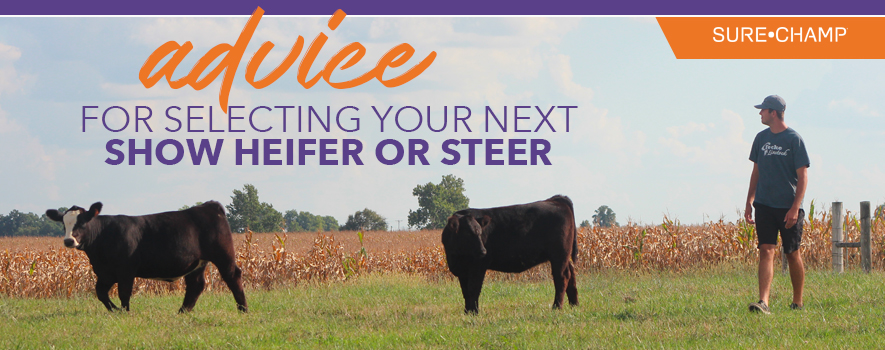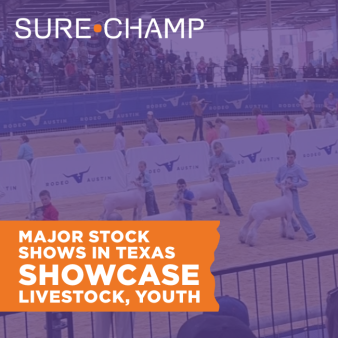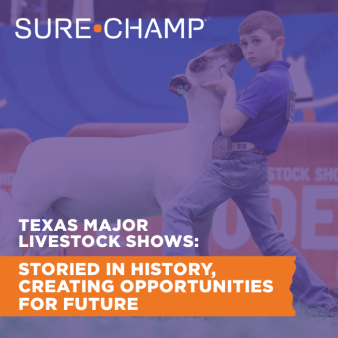
You’ve decided you want to show a steer or heifer, and it is prime time to start the selection and purchase process for your new project. There are magazines nearly two inches thick promoting every show steer open house in the Midwest; and then you start looking at all the online sales. It is easy to become overwhelmed with so many options.
However, before you even start looking for that next show prospect, you need to consider three factors and have a plan in place. Jessica Judge, BioZyme® Inc., Marketing Brand Manager, grew up showing cattle across the country and earned the title of High Individual at the 2017 North American International Livestock Exposition Intercollegiate Livestock Judging Contest, representing Oklahoma State University. She offers these considerations:
- Know your endpoint and end goal. If you are showing a steer, it might be county or state fair you are targeting for. If it is a heifer, it might be a similar show scenario, or you might have different goals for her, different places to show like a breed junior national and breeding goals. Know why you are ultimately purchasing your animal and you will have a better direction on size, age, breed and other specifics to look for.
- Know your budget. Some people simply have more money than others. An established, realistic budget will help you decide where you can go and determine what type of animal you can buy.
- Know the breeder/seller. Who have you formed a good relationship with? Who will help with feeding/prep advice after the sale? Be sure you have a solid relationship built on trust with the person you would like to do business with.
Once you have established the above criteria, you can start thinking about selection criteria for your animal. Regardless if you are looking to buy a steer or a heifer, the primary evaluation tool should be skeletal correctness or structure.
“At the end of the day, it doesn’t matter how heavily muscled they are or how attractive they are, if they can’t walk, it’s a wash. Structure is the most important characteristic to evaluate and select for,” Judge said.
Structural soundness should be evaluated from the ground up. First look at the animal’s foot size. Does the animal have a little, tiny foot on a small amount of bone? Or does it set down on a big, square foot and adequate bone? You want an animal that stands on a nice square foot, with a good set to its pastern and plenty of flexibility, which is why it is always important to watch them walk. Moving up the skeleton, you want to make sure that the animal has a good set to its shoulder angle and knee; there should be a 45-degree angle to its shoulder and the knee should have the proper curvature of a banana or crescent shape. Make sure the steer or heifer can get out and move with plenty of flexibility to its hip and hind leg. Finally, make sure the animal has natural, smooth joints as big joints indicate potential structural concerns which can lessen the long-term future and value of the animal.
Once you have evaluated structure, Judge offers specific traits a person should look for when selecting both steer and heifers.
Heifer Highlights
Judge said that when selecting a show heifer prospect, that after structure, you want to make sure the heifer has a productive and maternal look. This entails having a good rib shape, curvature to her rib design, softness to her overall skeleton and power. The heifer needs to have long-tying muscle shape and dimension, and not be just one-dimensional or flat.
The next selection criteria for a show heifer is balance and eye appeal – you want her to look like a lady.
“She should have a feminine shape to her head and neck and be clean through her throat. When selecting a female as a calf be sure to pay attention to her freshness and condition. She doesn’t need to be the bloomiest in terms of condition as a calf. You should look for a female who is genuine in her condition, but still shows potential for dimension and fleshing ability as she grows,” Judge said.
Other factors to consider on heifers include breed and age. Breed is truly a personal preference, as is age. Some ages will only be able to show at a national show or state fair once in a show season or calendar year, depending on the rules.
Steer Strategies
When evaluating potential show steer prospects, after structure, you will want to look at muscle shape. You don’t need to pick out the heaviest muscled, stoutest calf, but you do need to select one with indicators for future muscle development.
“Look for width of chest, some clearance or width at the ground, added body and rib shape, and a genuine shape or turn at the top side of his skeleton. These are good indicators that as he grows and develops, he will continue to have some muscle as he reaches his desired endpoint,” she said.
In addition to structure and muscle shape, you want a steer that is balanced and eye appealing. He doesn’t need to be the “coolest or freakiest fronted,” according to Judge, but he does need to have parts that are put together in a proportional package that give him a balanced, fat steer look.
Study the Past, Eyes on the Present
Judge recommends asking about the past performance of siblings and half siblings of the calves you are looking at buying, which goes back to having a good relationship with the seller. Find out how other calves from specific sires and cows have performed. Did they eat well and grow efficiently? Or were they hard keepers? If they took a while to gain, they might not be the right calf for your earlier endpoint. On the flip side, if they grow quickly and are earlier maturing, you may have to pump the breaks on your feeding strategy.
And although many people post photos and videos of their sales online, Judge recommends always studying the cattle in person. If you can’t get to a specific location in person, be sure that someone you trust looks at the cattle in person before you make a big investment in your project animal.
“If you see a calf you like, find someone you trust go see the animal in person. A lot of small details can be missed on videos, like foot size and joint shape. When you have steers that need to get to heavy weight or you are looking for a breeding female to bring value to your herd, those details can make all the difference,” Judge said.
You’ve established a budget; an endpoint and you’ve created relationships with reputable breeders. Now it is time to go select your next show heifer or steer project. With simple selection criteria, you can evaluate the groups of calves available for sale this fall and find your next champion.

